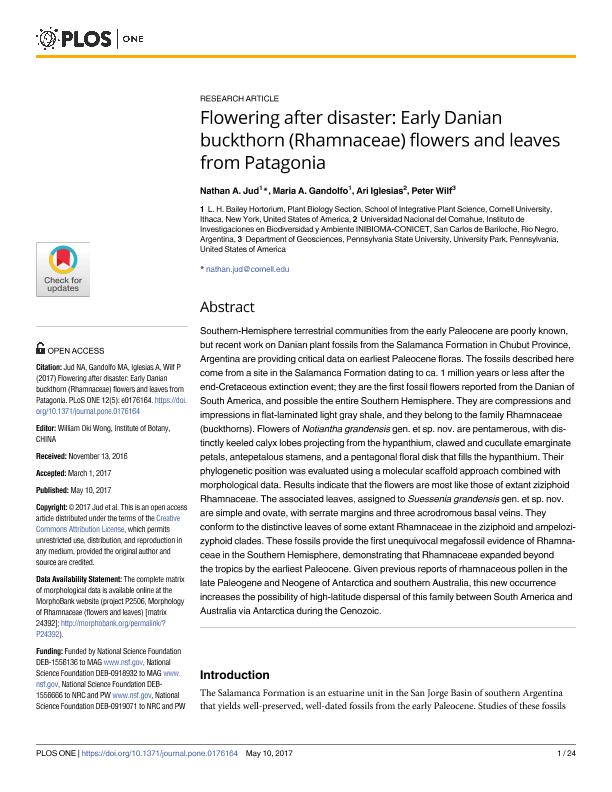Mostrar el registro sencillo del ítem
dc.contributor.author
Jud, Nathan A.
dc.contributor.author
Gandolfo, Maria A.
dc.contributor.author
Iglesias, Ari

dc.contributor.author
Wilf, Peter D.
dc.date.available
2018-11-13T19:40:06Z
dc.date.issued
2017-05-10
dc.identifier.citation
Jud, Nathan A.; Gandolfo, Maria A.; Iglesias, Ari; Wilf, Peter D.; Flowering after disaster: Early Danian buckthorn (Rhamnaceae); Public Library of Science; Plos One; 12; 5; 10-5-2017; 1-24; e0176164
dc.identifier.issn
1932-6203
dc.identifier.uri
http://hdl.handle.net/11336/64399
dc.description.abstract
Southern-Hemisphere terrestrial communities from the early Paleocene are poorly known, but recent work on Danian plant fossils from the Salamanca Formation in Chubut Province, Argentina are providing critical data on earliest Paleocene floras. The fossils described here come from a site in the Salamanca Formation dating to ca. 1 million years or less after the end-Cretaceous extinction event; they are the first fossil flowers reported from the Danian of South America, and possible the entire Southern Hemisphere. They are compressions and impressions in flat-laminated light gray shale, and they belong to the family Rhamnaceae (buckthorns). Flowers of Notiantha grandensis gen. et sp. nov. are pentamerous, with distinctly keeled calyx lobes projecting from the hypanthium, clawed and cucullate emarginate petals, antepetalous stamens, and a pentagonal floral disk that fills the hypanthium. Their phylogenetic position was evaluated using a molecular scaffold approach combined with morphological data. Results indicate that the flowers are most like those of extant ziziphoid Rhamnaceae. The associated leaves, assigned to Suessenia grandensis gen. et sp. nov. are simple and ovate, with serrate margins and three acrodromous basal veins. They conform to the distinctive leaves of some extant Rhamnaceae in the ziziphoid and ampelozizyphoid clades. These fossils provide the first unequivocal megafossil evidence of Rhamnaceae in the Southern Hemisphere, demonstrating that Rhamnaceae expanded beyond the tropics by the earliest Paleocene. Given previous reports of rhamnaceous pollen in the late Paleogene and Neogene of Antarctica and southern Australia, this new occurrence increases the possibility of high-latitude dispersal of this family between South America and Australia via Antarctica during the Cenozoic.
dc.format
application/pdf
dc.language.iso
eng
dc.publisher
Public Library of Science

dc.rights
info:eu-repo/semantics/openAccess
dc.rights.uri
https://creativecommons.org/licenses/by-nc-sa/2.5/ar/
dc.subject
Rhamnaceae
dc.subject
Patagonian Fossil
dc.subject
Paleocene
dc.subject
South America
dc.subject.classification
Meteorología y Ciencias Atmosféricas

dc.subject.classification
Ciencias de la Tierra y relacionadas con el Medio Ambiente

dc.subject.classification
CIENCIAS NATURALES Y EXACTAS

dc.title
Flowering after disaster: Early Danian buckthorn (Rhamnaceae)
dc.type
info:eu-repo/semantics/article
dc.type
info:ar-repo/semantics/artículo
dc.type
info:eu-repo/semantics/publishedVersion
dc.date.updated
2018-10-23T16:17:38Z
dc.journal.volume
12
dc.journal.number
5
dc.journal.pagination
1-24; e0176164
dc.journal.pais
Estados Unidos

dc.journal.ciudad
San Francisco
dc.description.fil
Fil: Jud, Nathan A.. Cornell University; Estados Unidos
dc.description.fil
Fil: Gandolfo, Maria A.. Cornell University; Estados Unidos
dc.description.fil
Fil: Iglesias, Ari. Consejo Nacional de Investigaciones Científicas y Técnicas. Centro Científico Tecnológico Conicet - Patagonia Norte. Instituto de Investigaciones en Biodiversidad y Medioambiente. Universidad Nacional del Comahue. Centro Regional Universidad Bariloche. Instituto de Investigaciones en Biodiversidad y Medioambiente; Argentina
dc.description.fil
Fil: Wilf, Peter D.. State University of Pennsylvania; Estados Unidos
dc.journal.title
Plos One

dc.relation.alternativeid
info:eu-repo/semantics/altIdentifier/doi/http://dx.doi.org/10.1371/journal.pone.0176164
dc.relation.alternativeid
info:eu-repo/semantics/altIdentifier/url/https://journals.plos.org/plosone/article?id=10.1371/journal.pone.0176164
Archivos asociados
